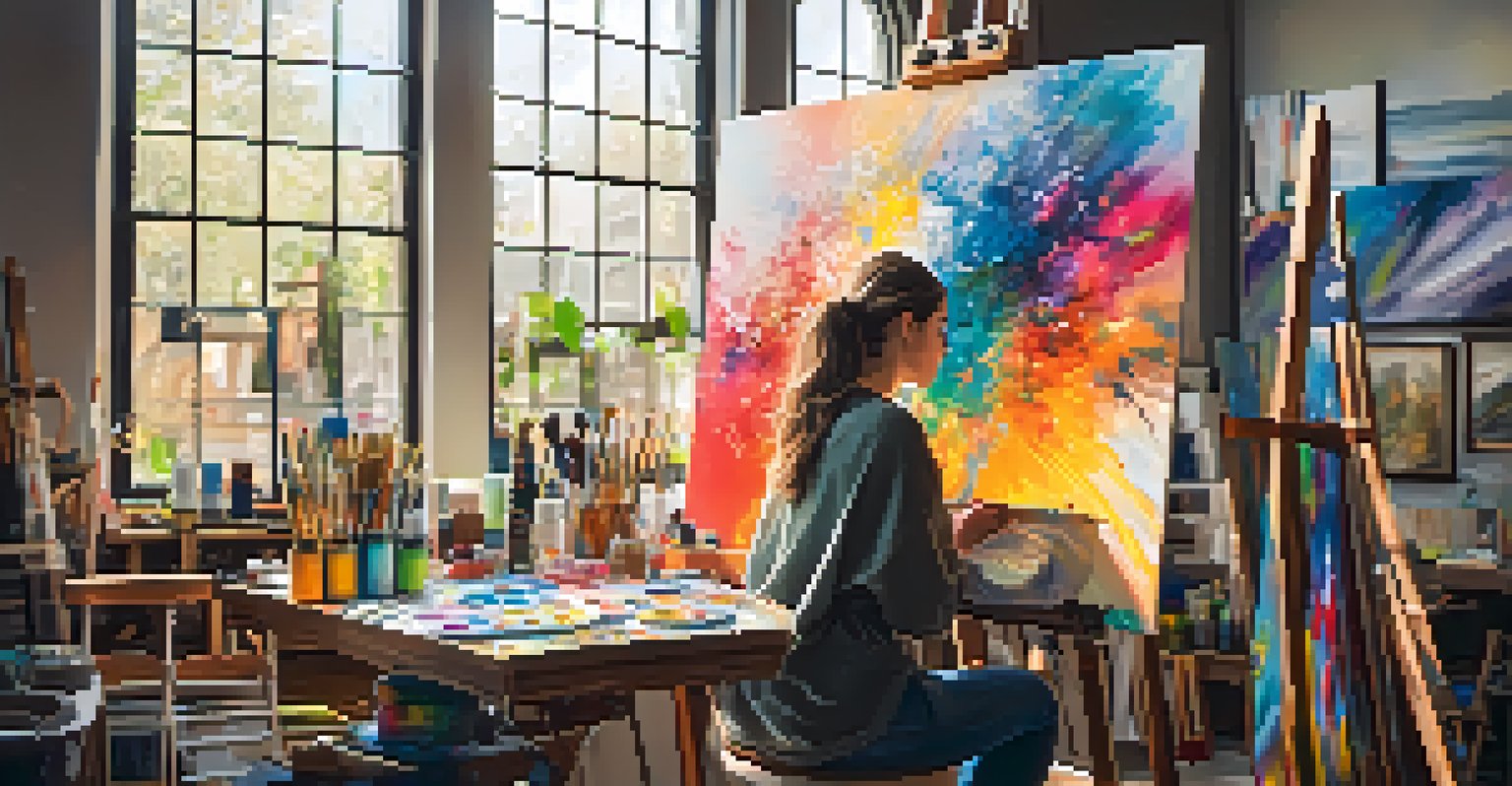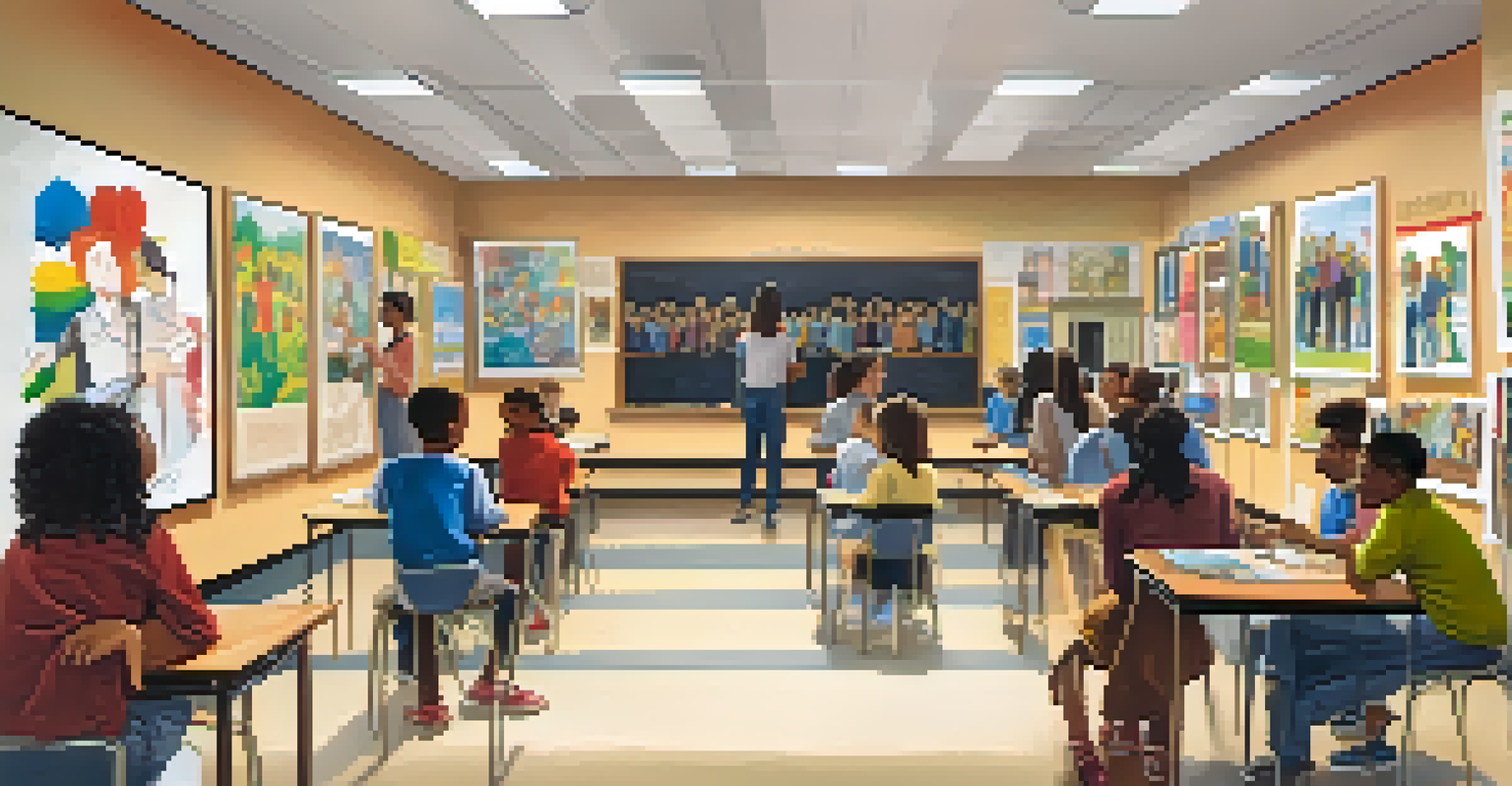Teaching Art History: Importance for Today's Students

Understanding Culture Through Art History
Art history serves as a window into the cultures and societies of the past. By studying the artwork created throughout different eras, students can better appreciate the context in which these pieces were made. This understanding fosters a deeper respect for diverse cultures and perspectives, which is increasingly important in our globalized world.
Art is the most beautiful of all lies.
For instance, learning about Renaissance art not only highlights the beauty of the work but also reveals how artists were influenced by the societal changes of their time. This connection between art and history allows students to grasp the evolution of human thought and creativity. Thus, art history becomes a tool for cultural literacy, enriching students' worldviews.
Moreover, engaging with art from various cultures encourages students to challenge stereotypes and biases. When students recognize the value in different artistic expressions, they cultivate empathy and open-mindedness, traits that are essential for collaboration in today’s diverse society.
Enhancing Critical Thinking Skills
Studying art history sharpens students' critical thinking skills as they analyze and interpret artworks. This practice involves questioning why an artist made certain choices and considering the implications of those decisions. Such analytical skills are transferable to various subjects and scenarios beyond the art classroom.

For example, when students examine a piece of modern art, they must consider the historical context, the artist's intent, and the societal reactions to the artwork. This multifaceted approach encourages them to think critically about sources of information and different viewpoints. By dissecting these layers, students become adept at forming well-rounded arguments and opinions.
Art History Enhances Cultural Literacy
Studying art history fosters a deeper appreciation for diverse cultures and perspectives, promoting empathy in a globalized world.
In a world saturated with information, the ability to critically assess and interpret data is invaluable. Through art history, students learn to engage thoughtfully with what they see, hear, and read, making them more informed citizens and effective communicators.
Fostering Creativity and Innovation
Art history isn't just about studying the past; it's also a source of inspiration for creativity and innovation. When students explore the works of artists, they often find themselves inspired to create their own art, drawing from the techniques and ideas they've encountered. This creative spark can lead to new forms of expression and thought.
Every artist dips his brush in his own soul, and paints his own nature into his pictures.
For instance, a student who studies the bold colors of Van Gogh may feel motivated to experiment with their own palette in a painting. This connection between historical art and modern creativity emphasizes the importance of learning from the past to inform future endeavors. As they analyze different styles and methods, students can expand their creative toolbox.
Additionally, this exploration encourages students to think outside the box. By understanding how artists broke conventions or challenged societal norms, students are inspired to push boundaries in their projects, fostering a culture of innovation that is crucial in today's fast-paced world.
Building Visual Literacy Skills
In our visually-driven society, the ability to interpret and critique images is more important than ever. Art history education helps students develop visual literacy skills, enabling them to understand and appreciate the significance of visual communication. This skill set is essential not just in art, but across various fields like marketing, media, and education.
For instance, when students learn to analyze a painting, they are not only deciphering its aesthetic elements but also understanding the underlying messages conveyed through imagery. This skill can translate into recognizing the persuasive techniques used in advertisements or social media content, empowering them to navigate the visual landscape critically.
Critical Thinking Through Art Analysis
Engaging with art history sharpens critical thinking skills as students interpret and analyze artworks, enhancing their ability to assess information.
Furthermore, as technology continues to evolve, so does the way we communicate visually. Students who grasp the nuances of visual literacy will be better equipped to engage with digital platforms and emerging media, ensuring they remain relevant in an increasingly visual world.
Promoting Emotional Intelligence and Empathy
Art has a unique ability to evoke emotions and convey human experiences, making it an effective tool for teaching empathy. Through art history, students can explore the feelings and narratives behind various artworks, fostering a deeper understanding of the human condition. This emotional engagement is crucial for their personal development and social interactions.
For example, when students study artworks that depict suffering or joy, they can relate these emotions to their own lives and the lives of others. This connection helps them cultivate empathy, as they learn to appreciate the stories and struggles that shape individuals and communities. Art history thus becomes a powerful medium for emotional growth.
In a world that often feels disconnected, fostering emotional intelligence through art can help bridge gaps between people. By recognizing shared feelings and experiences, students are more likely to build strong, compassionate relationships with others, ultimately contributing to a more empathetic society.
Encouraging Interdisciplinary Learning
Art history is inherently interdisciplinary, intertwining with subjects like history, literature, and sociology. This interconnectedness encourages students to make connections across different fields of study. By understanding the relationships between art and various disciplines, students gain a more holistic education.
For example, when exploring the art of a specific period, students can also learn about the historical events that influenced that art, such as wars, revolutions, or social movements. This deeper context enriches their learning experience, making it more engaging and relevant. It also illustrates how art reflects and shapes society.
Interdisciplinary Connections in Learning
Art history encourages interdisciplinary learning, helping students make connections across various subjects and preparing them for diverse career paths.
Moreover, interdisciplinary learning fosters collaboration and creativity. As students draw connections between art and other subjects, they develop a broader perspective that enhances their problem-solving abilities. This comprehensive approach is vital in an interconnected world that increasingly values diverse skill sets.
Preparing Students for Future Careers
Incorporating art history into education prepares students for a variety of career paths. Many fields, such as marketing, education, and design, benefit from an understanding of visual culture and historical context. By studying art history, students acquire skills that are directly applicable to these professional realms.
For instance, a student interested in a marketing career can leverage their knowledge of visual communication to create compelling campaigns. Understanding the principles of design and the cultural significance of various styles can give them a competitive edge in the job market. Art history becomes more than just an academic subject; it transforms into a useful career tool.

Additionally, the analytical and critical thinking skills gained through art history studies are highly valued by employers. As students learn to navigate complex ideas and present their thoughts clearly, they become strong candidates in any profession. Thus, art history isn't just about appreciating the past; it's also about equipping students for success in their future endeavors.